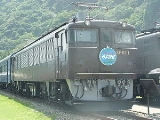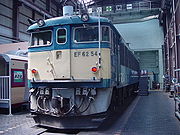
JNR Class EF62
Encyclopedia
A total of 54 Class EF62 DC electric locomotives were built between 1962 and 1969 for use hauling passenger and freight on the Shinetsu Main Line and particularly over the extreme 66.7‰ gradient of the Usui Pass
between Yokokawa and Karuizawa. The prototype, EF62 1, was built by Kawasaki Sharyō in 1962, with the full-production locomotives built by Kawasaki, Tōshiba, and Tōyō & Kisha delivered from 1963 onward.
The EF62s were the first adhesion locomotives used on the Shinetsu Main Line following the abandonment of the under-powered ED42 rack-and-pinion
locos dating from the 1930s. They were designed to work in multiple with pairs of the specially-designed JNR Class EF63
"Sherpa" locomotives between Yokokawa and Karuizawa.
While high adhesion was clearly an important requirement, the locos had to be designed with a low axle load (16 t, compared to 18 t for the EF63s) allowing them to be used on other sections of the Shinetsu Main Line with stricter axle-load restrictions. The need to reduce overall weight was one reason behind the decision to use the unique Co-Co wheel arrangement rather than the more commonly used Bo-Bo-Bo arrangement.
The need to reduce unnecessary weight led to the EF62s being the first DC electric locomotives in Japan to include an electric generator (320 kW) for train heating rather than using a steam generator. The locos also made extensive use of FRP (fibreglass-reinforced plastic) for roof panels, again to reduce weight.
Adhesion working started between Yokokawa and Karuizawa in 1963, and the journey time between these two stations was reduced from the 42 minutes taken on the old rack-and-pinion line to 17 minutes (ascending) and 24 minutes (descending). Train frequency was able to be increased, and freight trains of up 400 tonnes could be handled by an EF62 assisted by two EF63s. The EF62s were able to operate over the entire route from Ueno to Nagano, and were thus seen on a wide range of duties from freight to express passenger workings. The 1970s however saw a switch from loco-hauled to EMU passenger trains during the daytime, and so the EF62s primarily became freight locomotives.
Two members of the class, EF62 12 and 35, suffered an early demise when they were withdrawn following an accident in which they and two EF63s overturned after running away down the Usui Pass section.
The capacity and speed restrictions of the Usui Pass still represented a serious bottleneck, and in 1984, all freight operations over the section were discontinued and rerouted via the Chūō Main Line
. This made a large number of the class surplus to requirements, and 26 were reallocated to Shimonoseki depot in 1984 for use on Shiodome (Tokyo) to Shimonoseki freight services. However, the EF62s proved unsuitable for these duties, and this sub-fleet was withdrawn before JNR became JR in 1987, leaving a small number of locomotives still working on Shinetsu Mainline duties.
Privatization saw six EF62s pass into JR East's books for use on the overnight "Noto" express and seasonal trains. Three operational locos (EF62 43, 46, 54) remained when the Yokokawa – Karuizawa section was closed in October 1997, and their final duties involved hauling withdrawn EF63s for scrapping before they themselves were withdrawn in 1998.

in N gauge in standard blue (#2102) and original brown livery (#2182).
Usui Pass
The is a mountain pass that lies between Nagano and Gunma Prefectures in Japan. It has served as one of the major transportation routes in central Japan since at least the eighth century.- Road :...
between Yokokawa and Karuizawa. The prototype, EF62 1, was built by Kawasaki Sharyō in 1962, with the full-production locomotives built by Kawasaki, Tōshiba, and Tōyō & Kisha delivered from 1963 onward.
The EF62s were the first adhesion locomotives used on the Shinetsu Main Line following the abandonment of the under-powered ED42 rack-and-pinion
Rack and pinion
A rack and pinion is a type of linear actuator that comprises a pair of gears which convert rotational motion into linear motion. A circular gear called "the pinion" engages teeth on a linear "gear" bar called "the rack"; rotational motion applied to the pinion causes the rack to move, thereby...
locos dating from the 1930s. They were designed to work in multiple with pairs of the specially-designed JNR Class EF63
JNR Class EF63
The JNR Class EF63 is a class of 1,500 V DC electric locomotives formerly operating in Japan.-History:A total of 25 Class EF63 locomotives were built between 1962 and 1976 exclusively for use as bankers on the steeply-graded Usui Pass section of the Shinetsu Main Line between Yokokawa and Karuizawa...
"Sherpa" locomotives between Yokokawa and Karuizawa.
While high adhesion was clearly an important requirement, the locos had to be designed with a low axle load (16 t, compared to 18 t for the EF63s) allowing them to be used on other sections of the Shinetsu Main Line with stricter axle-load restrictions. The need to reduce overall weight was one reason behind the decision to use the unique Co-Co wheel arrangement rather than the more commonly used Bo-Bo-Bo arrangement.
The need to reduce unnecessary weight led to the EF62s being the first DC electric locomotives in Japan to include an electric generator (320 kW) for train heating rather than using a steam generator. The locos also made extensive use of FRP (fibreglass-reinforced plastic) for roof panels, again to reduce weight.
Adhesion working started between Yokokawa and Karuizawa in 1963, and the journey time between these two stations was reduced from the 42 minutes taken on the old rack-and-pinion line to 17 minutes (ascending) and 24 minutes (descending). Train frequency was able to be increased, and freight trains of up 400 tonnes could be handled by an EF62 assisted by two EF63s. The EF62s were able to operate over the entire route from Ueno to Nagano, and were thus seen on a wide range of duties from freight to express passenger workings. The 1970s however saw a switch from loco-hauled to EMU passenger trains during the daytime, and so the EF62s primarily became freight locomotives.
Two members of the class, EF62 12 and 35, suffered an early demise when they were withdrawn following an accident in which they and two EF63s overturned after running away down the Usui Pass section.
The capacity and speed restrictions of the Usui Pass still represented a serious bottleneck, and in 1984, all freight operations over the section were discontinued and rerouted via the Chūō Main Line
Chuo Main Line
The , commonly called the Chūō Line, is one of the major trunk railway lines in Japan. It runs between Tokyo and Nagoya, although it is the slowest direct railway connection between the two cities; the coastal Tōkaidō Main Line is slightly faster, while the Tōkaidō Shinkansen is the fastest rail...
. This made a large number of the class surplus to requirements, and 26 were reallocated to Shimonoseki depot in 1984 for use on Shiodome (Tokyo) to Shimonoseki freight services. However, the EF62s proved unsuitable for these duties, and this sub-fleet was withdrawn before JNR became JR in 1987, leaving a small number of locomotives still working on Shinetsu Mainline duties.
Privatization saw six EF62s pass into JR East's books for use on the overnight "Noto" express and seasonal trains. Three operational locos (EF62 43, 46, 54) remained when the Yokokawa – Karuizawa section was closed in October 1997, and their final duties involved hauling withdrawn EF63s for scrapping before they themselves were withdrawn in 1998.
Preserved examples

- EF62 1 Usui Pass Railway Heritage ParkUsui Pass Railway Heritage ParkThe is an open-air railway museum located in Annaka, Gunma, Japan. It is operated by East Japan Railway Company , and was opened on 18 April 1998 on the site of the former Yokokawa motive power depot alongside the Shin'etsu Main Line, which closed in October 1997....
, Gunma - EF62 3 Stored at JR-East Nagano Works
- EF62 18 JR-East Ōmiya Works (cab section only)
- EF62 54 Usui Pass Railway Heritage ParkUsui Pass Railway Heritage ParkThe is an open-air railway museum located in Annaka, Gunma, Japan. It is operated by East Japan Railway Company , and was opened on 18 April 1998 on the site of the former Yokokawa motive power depot alongside the Shin'etsu Main Line, which closed in October 1997....
, Gunma
Models
The EF62 was produced by TomixTomix
Tomix is model railway brand of the Japanese company Tomytec, a subsidiary of toy manufacturer Takara Tomy .-Product outline:...
in N gauge in standard blue (#2102) and original brown livery (#2182).

